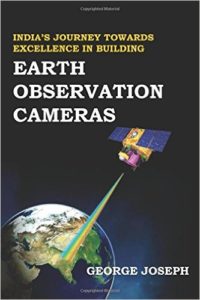
Title: India’s Journey Towards Excellence In Building Earth Observation Cameras
Publisher: Notionpress.com
Author: Dr George Joseph
ISBN: 978-93-5206-998-9
As a late joiner to the space club, India’s space program was in “catch-up” mode for most of its early history. Never the less, original technological innovation did take place. In this book, Dr George Joseph describes how the electro-optical sensors used on-board India’s Earth Observation satellites were designed, built and deployed. He knows because he was at the forefront leading this work during the 1970s and 1980s.
As with any account written by the those who are intimately involved, Dr Joseph brings a level intimate detail and authenticity that is not otherwise available. His arrival at ISRO in 1973 was timely. He lead the team that built the imaging system (image intensifier and vidicon tube) for India’s first Earth Observation satellite, Bhaskara-1. In the 200 pages, the book traces ISRO’s deployments of new techniques and technology as the Indian Remote Sensing program (IRS) evolved during the 1980s. The quality and quantity of data captured increased as multispectral, stereoscopic, higher specification optics and digital technology was introduced.
ISRO’s history is littered with examples of imaginative solutions to overcome the deficit of resources. Images of rocket nose cones transported on bikes or a bullock cart with rubber wheels for testing satellite antenna in a non-magnetic environment, have generated iconic images. They represent a lasting public perception of the ingenuity and frugality of the Indian space program. Dr Joseph describes another. In 1973 when a dark room was not available, a kitchen in a residential apartment was converted in to one along with the solid work surface to an optical bench.
Most of the book is readable for anyone with an interest in this subject. Since, Dr Joseph is a scientist, some technical terms such as “Modulation Transfer Function” and “scan mirror for off nadir viewing” are present. Although the book traces the evolution of imaging systems which was the author’s primary contribution during the early phase, it covers how those early techniques and technologies continue to support the 2008 Moon mission and the 2013 ISRO’s Mars Orbiter Mission.
Chapter 10 highlights another of ISRO’s contribution that many, even within India, do not appreciate – international collaboration. The US Landsat series of Earth Observation satellites was the premier supplier of Earth Observation data. During the 1980s, 1990s, and early 200s, problems with Landsat 5, 6 and 7 coincided with the time that ISRO’s EO constellation of satellites matured. Despite the very different pedigree, ISRO EO data was sought by many nations to fill the gap left by Landsat. Chapter 10 looks at several examples of how data from ISRO’s satellites is used by Australia, Sweden, Italy USA, Brazil and Kuwait to help toward understanding and mitigating against the effects of climate change.
The book is fascinating resource not only detailing the evolution of a key asset of satellite imaging systems but the personal account of how that was achieved. An appendix with 5 sections at the end deals with some of the more technical and specialised areas such as Bhaskara TV Camera Failure Analysis, Supplementary Notes, Space based Electro-Optical Cameras of ISRO, Glossary and Memory Lane. I found the Supplementary Notes and Memory Lane sections particularly interesting. They contain transcriptions of letters, notes and several B&W images of high quality capturing some of the key events from the time when the author was engaged with his ground breaking work.
This is an interesting read, even if you have no interest in ISRO per se. The description of space based imaging systems, by someone who built them, is sufficient justification for acquiring a copy. How could the work be improved? This book has one of the better quality of post production that I have seen. Despite this however, there are some minor typos that do not get in the way of comprehension but are a distraction. Something that copy editing or proofreading should have picked up. The other is my frequent complaint – absence of an index. The book is available on paperback from Amazon but hardback only from the publisher in India www.notionpress.com. It is incomprehensible that in 2016, an ebook is not ALWAYS made available at time of publication. A sample of the book, the forward, is available on the author’s personal website.
Leave a Reply